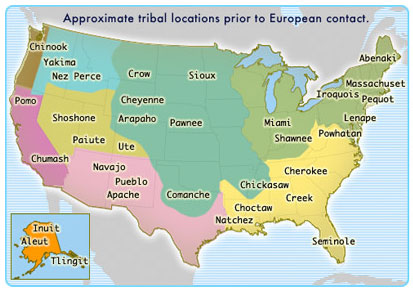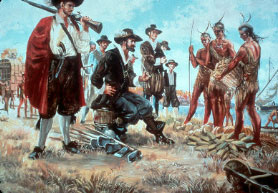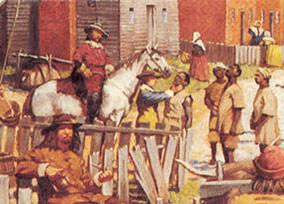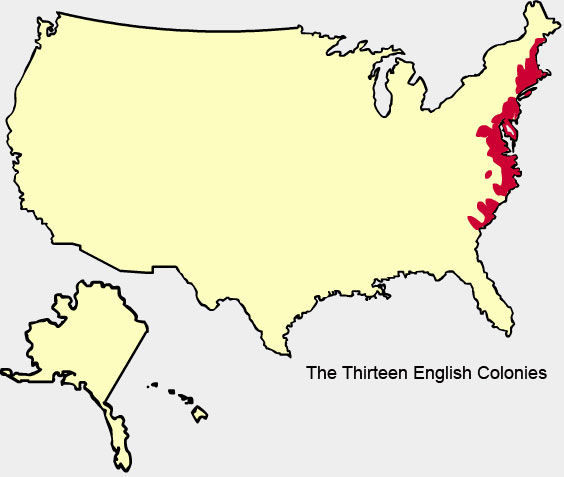
Before we discuss immigration to America, it is important to understand that there were people who existed in the United States long before European immigration began. American Indians were inhabitants of the land before the first permanent settlement, Jamestown, Virginia, was established. The map below illustrates the location of various American tribes before their contact with Europeans.

In the picture below, Englishman John Smith is meeting with the Powhatan Indians to get more food for the settlers of Jamestown.

Source: John Smith getting trading with Indians,
National Park Service
The first Virginians arrived from England in 1607. They were sent from England to look for gold or a passageway to China through this new country. Economic opportunity was the main goal of the original settlers of this area. Jamestown endured many hardships, but eventually it became a successful settlement. Seeing this, more people left England in search of the opportunities held by the Jamestown colony. Additionally, many of the settlers of Jamestown migrated beyond Virginia.
By 1619, the face of the settlers changed in Virginia. Jamestown settlers were predominately white men; there were very few women among the settlers. In late August of that same year, the first boatload of Africans arrived at Jamestown. They were sold or traded into servitude in exchange for supplies. The Africans of Jamestown lived as indentured servants who worked for several years and then gained their freedom.

This is a painting depicting the slave trade in Jamestown in the 1660s. Newly-arrived Africans are being inspected by an English settler before sale or trade.
→ Quick Reflection: What is the difference between the Africans who were sold or traded into indentured servitude and those Africans who were later sold into slavery?
Interactive popup. Assistance may be required.
Africans who were sold or traded into indentured servitude were given their freedom after a prescribed time, whereas those who were sold into slavery were not given a time frame for emancipation.

As European immigration to the colonies increased, the American colonies became more diverse. The European explorers claimed territories in North America for their respective countries, and the people of those countries soon immigrated to North America.

Soon the new territories were filled with individuals from different lands who spoke different languages and had different beliefs and customs. As the colonies expanded, so did the diversity of the people who lived in them. In addition to the English colonists, colonists from other countries contributed to the diverse culture of the United States.
Scroll over the areas on the map below to see the colonies. Click on the colonies for more information.
Click on the link below to play a game that tests your knowledge of American English words with Spanish origins.
The paint cans below represent the countries with colonies in America. Click on the paint cans and then click on the corresponding part of the map to paint the map. Where were the English, Dutch, French and Spanish colonies?
Sources of images used for this section as they appear, top to bottom: